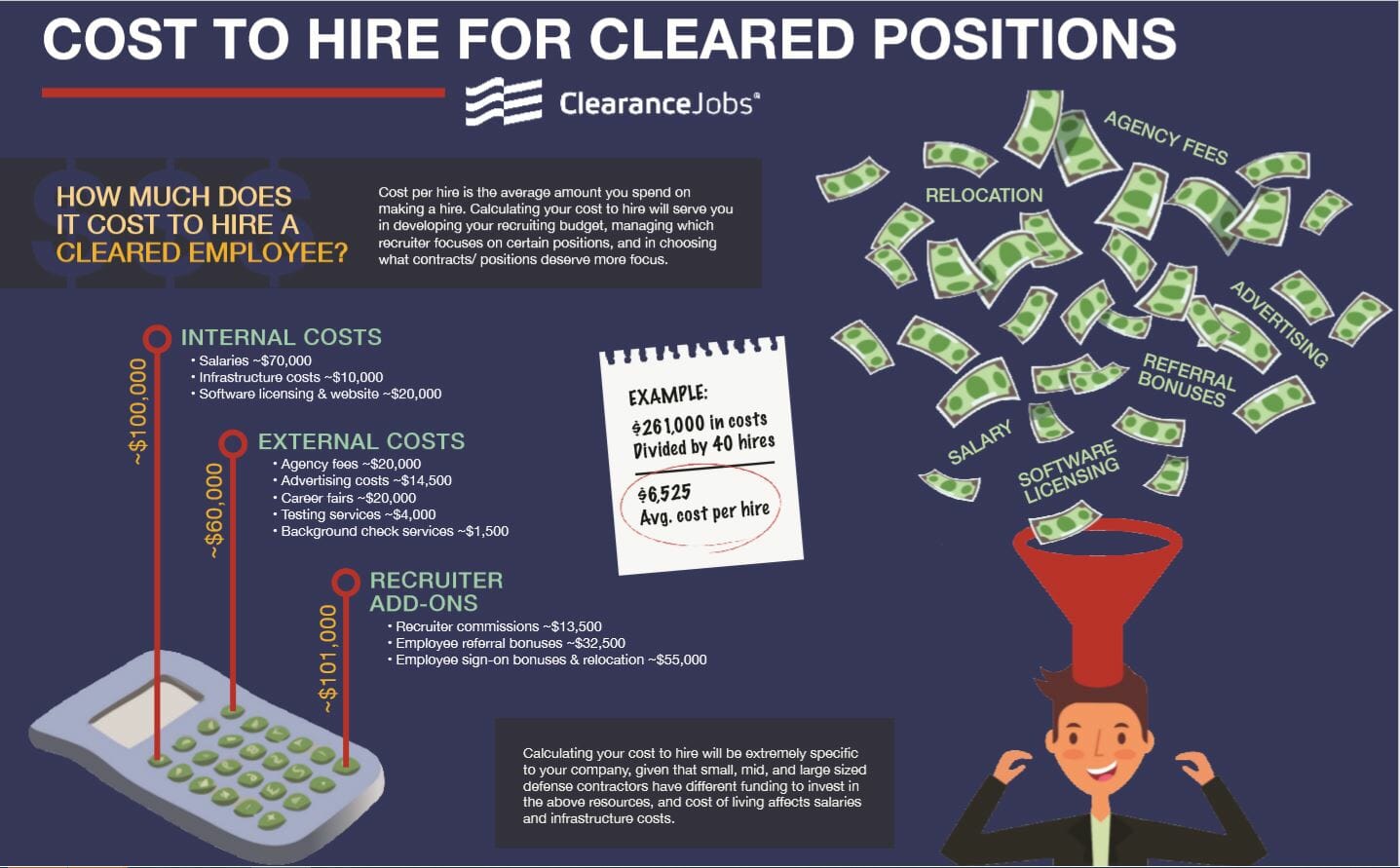Since the emergence of analytics, calculating return on investment and other quantifiable data is imperative for any team in any industry. Cleared recruiting is no different as talent acquisition teams in the defense industry are expected to fill newly awarded contracts, staff proposal efforts, fill positions experiencing turnover, research the newest software tools, and much more.
Cost per hire is the average amount of funds you spent on making a hire. Calculating your cost to hire will serve you in developing your recruiting budget, managing which recruiter focuses on certain positions, and in choosing what contracts / positions deserve more focus. For example, if you plan to hire 50 people in a year, and your cost per hire is $1,000, you can estimate a total spend of $50,000 for recruiting. It is also beneficial to compare these annually over several years to spot any substantial changes.
While the Society for Human Resource Management’s (SHRM’s) listed the average cost-per-hire in 2016 as $4,129 across all industries between small, medium and large businesses, each company will have their own cost to hire value depending on business size, employee size, location, etc.
To calculate your cost to hire for cleared positions in the defense industry, you will add your internal recruiting costs, any external costs, and divide by the total number of positions your company needs to fill.
INTERNAL COSTS
- Salaries: Whether it’s an HR manager, a hiring manager, a facility security officer, the recruiter or an assistant, any salaried employee contributing to the hiring process should be considered, by estimating the number of hours they spend working on a given hire.
- Infrastructure costs: This cost includes any physical spaces used during the hiring process such as your office. To estimate these, take the fraction of your office devoted to hiring over the year, and multiply it by the fraction of time those spaces are used for hiring, then multiply the result by your total annual rent and utilities.
- Software licensing / website: Are there costs associated with your Applicant Tracking System? This along with costs devoted to creating and maintaining your company’s careers page should be included as well.
EXTERNAL COSTS
- Agency fees: This includes any staffing agencies you utilize on a contract basis, headhunters, consultants, etc.
- Advertising costs: This takes the form of job boards or any other recruitment marketing costs.
- Career fairs: Here you will include fees for recruiting events and any non-salaried staffers and travel expenses for those who are salaried.
- Testing services: Also, this is a perk in the hiring process that is few and far between for smaller defense contractors, the cost of any organizations you use to perform aptitude tests or pre-screening during the pre-interview stage should be included.
- Background check services: Any fees for background checks.
ADD-ONS
- Recruiter commissions: Have an on-staff recruiter? If they’re salaried, you can use the same formula as above, for a per-position breakdown, or divide by the total number of positions filled in the year for a per-position average. If they’re working on commission, be sure to add the cost of that to your total.
- Employee referral bonuses: Note that you might have bonuses marked differently in your budget — as a bonus line-item, for instance, rather than a hiring cost—but this cost should still figure into your cost to hire.
- Employee sign-on bonuses or relocation costs.
EXAMPLE
Calculating your cost to hire will be extremely specific to your company, given that small, mid, and large sized defense contractors have different funding to invest in the above resources, and cost of living affecting salaries / infrastructure costs. Let’s walk through the cost to hire for a small-sized defense contractor in Washington DC.
First calculate employee hourly salaries (i.e. $80,000 / 48 work weeks a year / 40 hours a week = $41.67), then multiply it by the hours spent per hire. 98.3 days is the average time to hire for the federal government. Cleared contractors can likely shave a month or more off of this figure, but should factor in the time it takes for clearance investigations or reciprocity to come through, when necessary.
Average cost to hire varies significantly by company and position.
A 2016 study by the Society of Human Resource Management put the average cost to hire at $4,129. A 2018 study by the National Association of Colleges and Employers put the figure at $6,110. For cleared companies, where there is a need to layer FSO costs and background investigation delays, the average cost to hire can tick up from the average by 10-20% or more.
HOW TO OPTIMIZE YOUR COST TO HIRE
Cost per hire depends on hiring volume. The more people you hire, the lower your cost per hire will be. This is because some fixed costs can be spread out over a larger number of hires. Also, some roles in the defense industry have longer time to fill and the accumulated costs of a longer hiring process result in higher costs per hire.
To make your process as efficient and effective as possible, invest in hiring tools and techniques that work for you. Here are a few ways to be more effective with ClearanceJobs:
- Build talent pipelines with ClearanceJobs. Talent pipelines are groups of candidates you have screened and engaged before a position opens. When you have a vacancy, you can immediately contact these candidates without having to wait for applications and conduct screening calls. Utilize tagging tools to organize your candidates.
- Utilize Workflow to automate manual tasks. With Workflow automating tedious and repetitive recruiting processes, recruiters are free to invest more of their time on relationship building, interviewing, events, and other more time-intensive tasks.
